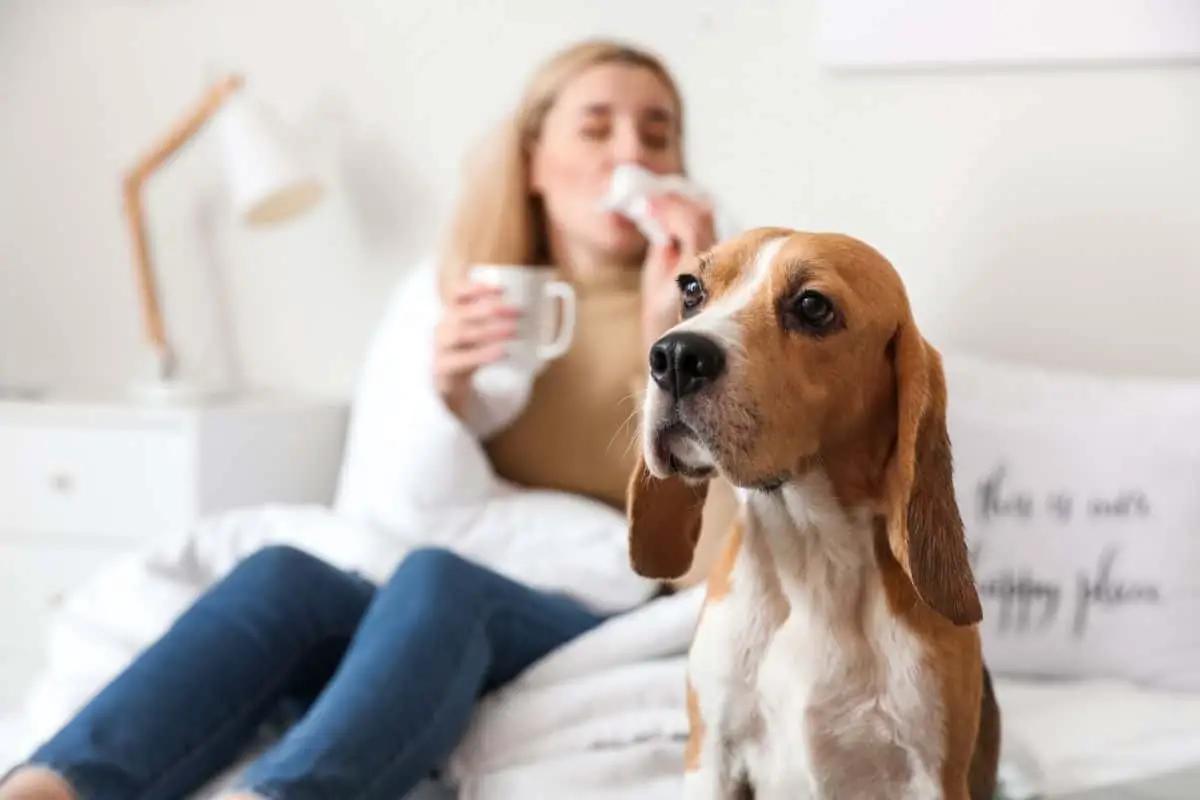If you suffer from allergies and you’re looking to get a hound you may be wondering which hound dogs are considered hypoallergenic. Hounds generally make excellent pets, showing incredible loyalty to their owners and having gentle loving personalities. Although initially bred for hunting, many hounds have become the sort after dog breed for families in recent times.
The Afghan Hound, Basenji, and the Italian Greyhound are three hypoallergenic hound breeds. You should also know, hound dogs tend to shed relatively less compared to most other dog breeds, but despite only certain hounds have been deemed hypoallergenic.
In this article, I’ll talk more about what it means to be hypoallergenic and some details of the hounds that would be considered hypoallergenic.
Definition of hypoallergenic
Hypoallergenic means being less likely to cause an allergic response. To be hypoallergenic means the reason or cause to trigger an allergic reaction is unlikely.
However, just because a dog is not considered hypoallergenic does not mean you will have allergy issues. For example, I am mildly allergic to dogs, but I have two long-haired miniature dachshunds. I am careful about keeping them bathed and brushed regularly, but other than that I have no issues.
What does it mean for a dog to be hypoallergenic?
A dog can be hypoallergenic. A hypoallergenic dog does not lose as much fur as other, non-hypoallergenic, dogs do. This means a hypoallergenic dog is less likely to trigger an allergic reaction to someone who suffers from allergies to dogs.
A dog that loses very little to no fur means that dander, the leading cause of allergies from dogs, attached to its falling hair is not released excessively. People who suffer from allergies may experience allergic reactions to dander.
As much as there are hypoallergenic dogs, the fact is that no dog, no matter how often it loses fur, is ever fully hypoallergenic. Several scholars disagree on whether or not to use the word hypoallergenic when categorizing dogs. It is because all dogs do have fur that sheds. Also, people have different responses to dogs. It may not be the hairs and dander only that may result in allergic reactions.
To clearly understand hypoallergenic dogs, we discuss each breed individually. These dogs may all be considered hypoallergenic but have different characteristics that make them hypoallergenic.
Afghan Hound
Afghan hounds are considered sighthounds. Breeders initially used them for hunting big game. More recently Afghan hounds have become domesticated dogs, as they are not known to be aggressive dogs and make great family pets.
Initially from Afghanistan, as the name suggests, this dog breed is characterized by a thick, fine, and long silky coat and a tail ending in a circular curl. It has a striking profile owing to its powerful arched neck, big hips, and huge paws.
Afghan hound shedding
This dog is a low-shedding breed. Less shedding means that the afghan coat produces little to no dander. It makes the dog less likely to cause allergic reactions to people who suffer from allergies.
Afghan hounds differ from other dog breeds as they only have one coat. Most dog breeds have two coats, a topcoat, and an undercoat. Because of this, Afghan hounds do not shed as nearly as much as other dogs.

Afghan hound fur is much more like human hair since it is constantly growing, requiring regular trimming. This implies that the hair on afghan hounds does not get to a ‘’shedding phase’’ as frequently as most dog breeds which mean less shedding. However, Afghan hounds do shed when they are transitioning from puppy to adult.
Their puppies are characterized by short fluffy fur. This fur may start falling off at the ages of 9 to 12 months, giving way for a new, glossy, much longer coat to grow. It’s only at this period that afghan hounds tend to shed frequently.
Generally, although they are hypoallergenic, Afghan hounds are high maintenance dogs. Their long silk flowing hair requires constant grooming.
Managing your Afghan hound coat
Afghan hounds need a considerable amount of time set to care for their coat. They are high maintenance dogs. They may not require frequent baths, but brushing is essential to keep their coats in good shape. You should always leave the hair thick, silk and fine.
The use of quality sprays to moisten the hair before brushing is recommended. Always brush the Afghan hound from the skin out. Poor grooming will leave mats in the coat.
Basenji
Commonly referred to as the ‘’barkless dog,’’ even though they’re not a really silent dog, basenji are a hunting sighthound breed originating from Africa. It is a small-sized dog, recognized by its short hair, wrinkled forehead, and high and curled tail.
Basenjis are no longer often used for hunting, but they make excellent family dogs. Basenjis are known to be highly protective of their owners. However, they require a lot of early socialization with other people to be good companions.

Basenjis are hypoallergenic. They are considered a low shedding breed. Low shedding means less fur and dander is produced that may cause allergic responses to people who have dog allergies. They have a meticulous grooming routine, almost cat-like, without any of the typical dog smell.
Basenji shedding
Basenjis are a low-shedding dog breed. However, like any other dog, they do shed some hair, although very little. Basenji tend to shed during seasonal changes such as spring and fall, which mostly lasts only a few weeks.
In their shedding periods, it can be slightly more or even, in some cases, significantly more as their coat sheds naturally in readiness for a new season. However, their shedding may not be noticeable, and this is because of their short coat.
Most hypoallergenic dog breeds tend to be high maintenance. However, these dogs are of significantly lower maintenance and require less grooming compared to other dog breeds. A daily brush or just often will keep your basenji’s coat in excellent condition. They make a perfect choice for someone who suffers from dog allergies.
Italian Greyhound
Italian greyhounds are sleek and thin sighthounds. It looks more like the standard greyhound but miniature in size. Its coat is smooth and shiny and comes in a variety of shades. Italian greyhounds make great family dogs, but it requires early socialization to get acclimatized with new people and situations quickly.
This dog breed tends to be attached to its owners and wants a lot of company. In other words, they are clingy dogs. They hate being left alone for long periods and may show their unhappiness through destructive chewing.

Unlike the normal greyhounds, the Italian greyhound is hypoallergenic. It can be an ideal pet for those people who suffer from dog allergies.
They are considered hypoallergenic because of their short and odorless coat. These dogs are relatively small and thus have less hair. The hair of the Italian greyhound is also relatively short. As a result, even when shedding, the odds of a severe allergic reaction are extremely low.
Italian greyhound shedding
The Italian greyhound is a low-shedding dog breed. Unlike most dogs with a double coat, an undercoat, and a topcoat, the Italian greyhound has a single coat; much like the Afghan hounds. This is also one of the main reasons why it sheds so little. Being single-coated means that these dogs do not shed seasonally compared to a double-coated dog.
An Italian greyhound’s fur is smooth and short, which means that it will probably go unnoticed even when they do shed. The chances of you having an allergic response are minimal.
These dogs are also the smallest sighthounds on the planet. Their size means that there isn’t much hair that can shed off of them. Less shedding means low to no production of dander which causes allergies. They make an excellent dog for people who are affected by dog allergies.
Does hypoallergenic mean a dog is allergy-free?
Although these dogs are considered hypoallergenic, we cannot say that they are allergy-free. All dog breeds shed some fur. Hypoallergenic only highlights the fact that a dog is less likely to cause allergies. Therefore, no dog is ever “fully hypoallergenic.”
Most of these hypoallergenic dogs mainly shed during the transition from puppies to adult dogs or occasionally during seasonal changes.
An allergic reaction may also be triggered not by fur or dander, but rather by urine and saliva coming from your dog as it is scratching or playing around. This is caused by a protein that can cause an allergic response in someone who may be susceptible.
Dog breeds like the basenji like to groom themselves, and spreads protein on their coat, leading to an allergic reaction to someone responsive to it.
It is important to note that how you take care of your dog impacts how severe of an impact this can have on your allergies, even though they may be considered hypoallergenic. Not grooming your dog regularly or poor nutrition might not keep their skin healthy, and you may encounter some extreme or more than usual shedding as well as dander formation.
The type of food you give to your hound dogs will determine their health status. Some foods have no nutritional value or the required balance of nutrients. Good nutrition helps to keep their coats healthy, soft, and shiny.
An excellent grooming routine also helps. Although dogs like the Basenji and the Italian greyhound may be of relatively low maintenance, poor grooming will leave them prone to causing allergies. Leaving your dog’s skin dry increases their shedding and dander formation.
Regular grooming, which may involve a weekly brush or scrub for your dog, will ensure that the protein from dry saliva and urine does not accumulate on their skin.
How will my hound dog being hypoallergenic affect my seasonal allergies?
Hypoallergenic dogs do not shed as much as other dog breeds; hence are less likely to create allergy problems even if the allergen is on their fur. However, being hypoallergenic can affect your seasonal allergies by decreasing the number of allergens in the house. This is a good thing!
However, hounds are high energy dogs and like to play and run around. This may make them get into contact with allergens that may rest on their coat. They may carry this into your house or other items you get into contact with frequently. Stick to good grooming or brushing routines and this should be no problem.
If you shave your hound dog, will it make it hypoallergenic?
Shaving or trimming your dog will not make them hypoallergenic. Genetics, breeding, and the sort of hair or fur your dog has are what determines whether or not they would be considered hypoallergenic.
Shaving any dog will only make its fur shorter, and this has nothing to do with how much it sheds. For an Afghan hound, its coat must never be shaved. The fur should be thick, smooth, and fine in texture. Other hypoallergenic hound dogs have relatively short hair and thus would be far more difficult to shave.
Finally, while getting a hypoallergenic hound may be a good choice for people who suffer from dog allergies, it is not guaranteed that you will not have any allergy issues. It’s important that you consult with your doctor first to know what allergies you suffer from and deciding whether or not getting a hound is for you.
Other Hypoallergenic Dog Breeds
If you do have your heart set on getting a hypoallergenic dog, the following is a list of non-hound dogs that are also considered hypoallergenic.
- Bichon fries
- Coton de Tulear
- The Giant, standard and miniature Schnauzer
- Irish water spaniel
- Kerry blue terrier
- Lagotto Romagnolo
- Maltese
- Poodle
- Bedlington terrier
- Scottish terrier
- Portuguese water dog
Again, even though these dogs are considered hypoallergenic, you cannot entirely rule out the fact that they may shed. However, they are less likely to trigger an allergic reaction to their owners or other people they interact with.



